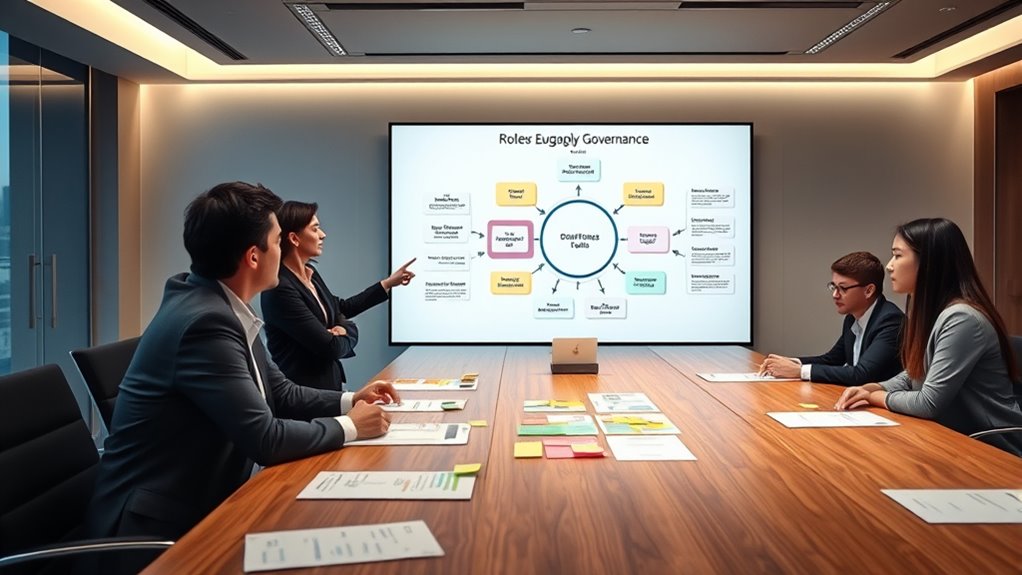To manage your content effectively, you need clear roles, responsibilities, and review cycles. Using a RACI matrix helps you assign who creates, approves, consults, and stays informed about content, preventing confusion. Regular review cycles ensure your content remains accurate and compliant, while ongoing communication and training keep everyone aligned with standards. Implementing these strategies strengthens your content governance and ensures consistency. Keep exploring to learn how to optimize these processes for your organization.
Key Takeaways
- Clearly define roles using a RACI matrix to assign Responsible, Accountable, Consulted, and Informed parties for content tasks.
- Establish regular review cycles (quarterly or annually) to ensure content accuracy, compliance, and relevance.
- Use RACI to streamline decision-making, reduce overlaps, and clarify responsibilities in content creation and approval processes.
- Implement automated reminders and documentation to maintain ongoing review schedules and accountability.
- Provide continuous training and updates to roles and standards, fostering a culture of consistent content governance.

Content governance is essential for ensuring that your organization maintains control over its digital content, aligns with brand standards, and complies with legal requirements. When you establish clear roles and responsibilities, you create a structured environment where everyone knows their part in managing content effectively. This clarity helps prevent confusion, reduces errors, and ensures that content is consistent, accurate, and compliant across all platforms. By defining who does what, you streamline decision-making processes, making your content management more efficient and reducing bottlenecks.
Clear roles and responsibilities streamline content management, prevent errors, and ensure consistency and compliance across platforms.
A fundamental aspect of effective content governance is understanding and implementing a RACI matrix. RACI stands for Responsible, Accountable, Consulted, and Informed. When you assign these roles clearly, you specify who is responsible for creating, editing, and publishing content, who has ultimate accountability for its quality and compliance, who needs to be consulted during the process, and who should be kept informed of progress or changes. This framework minimizes overlaps and gaps, ensuring that everyone involved knows their duties and boundaries. It also facilitates communication, so that feedback flows smoothly and decisions are made swiftly. For example, content writers might be responsible for drafting, while a content manager is accountable for final approval. Subject matter experts may be consulted for technical accuracy, and marketing teams are kept informed of updates to align messaging.
Review cycles are another critical element in maintaining high-quality content. You need to establish regular review schedules to ensure that content remains relevant, accurate, and aligned with evolving standards. Whether it’s quarterly updates or annual reviews, setting specific review dates helps prevent outdated or incorrect information from lingering online. During these reviews, you evaluate content for compliance, consistency, and performance. This process also allows you to incorporate new insights, update visuals, and refine messaging to meet current audience needs. When you automate reminders for review cycles, it becomes easier to stay consistent and accountable, reducing the risk of neglecting important updates.
Additionally, understanding the cost factors involved in content governance, such as resource allocation and budget considerations, can help optimize your review processes and ensure sustainable management practices. Finally, effective content governance requires ongoing communication and training. As your organization grows or changes, roles may shift, and new content areas might emerge. Ensuring that everyone understands their responsibilities and the importance of governance practices helps maintain standards over time. Providing regular training sessions and clear documentation creates a culture of accountability and quality. When you embed these practices into your daily operations, you safeguard your brand’s integrity, improve content effectiveness, and stay compliant with legal and industry standards.
Frequently Asked Questions
How Do I Handle Conflicting Stakeholder Opinions in Content Governance?
When faced with conflicting stakeholder opinions, you should facilitate open communication to understand each perspective. Encourage collaboration and identify common goals. Use data and clear criteria to support decision-making, and if needed, escalate disagreements to a higher authority or consensus group. Staying neutral and focused on the overall content strategy helps you mediate effectively, ensuring decisions align with organizational objectives while respecting stakeholder input.
What Tools Are Best for Tracking Review Cycles and Approvals?
You should use tools like Trello, Asana, or Jira to track review cycles and approvals effectively. These platforms let you assign tasks, set deadlines, and monitor progress in real-time. They also enable collaboration, so everyone stays updated on approval statuses and review deadlines. Automating reminders and notifications helps guarantee reviews stay on schedule, minimizing delays and keeping your content governance process smooth and transparent.
How Often Should Content Review Cycles Be Scheduled?
Imagine your content process as a garden that needs regular tending. You should schedule review cycles every 4 to 6 weeks to keep your content fresh and healthy. This rhythm allows you to prune outdated material, nurture new ideas, and guarantee consistency. By sticking to this schedule, you prevent overgrowth and maintain quality, much like a gardener who knows when to water, prune, and harvest for a thriving, vibrant garden.
How Can I Ensure Compliance With Industry Regulations?
You can guarantee compliance with industry regulations by staying informed about relevant laws and standards, regularly training your team on compliance requirements, and implementing clear policies. Use automated tools to monitor content for regulatory adherence, conduct periodic audits, and establish a review process that includes legal or compliance experts. Keep documentation of all reviews and updates, and foster a culture where team members feel responsible for maintaining compliance at every stage.
What Training Is Recommended for Content Governance Team Members?
You should have your content governance team undergo training on industry regulations, compliance standards, and best practices. Enroll them in courses on data privacy, copyright laws, and content quality assurance. Additionally, provide workshops on regulatory updates and risk management. Regularly updating their knowledge guarantees they stay compliant and avoid legal issues. Encourage certifications like Certified Information Privacy Professional (CIPP) or Compliance Certification to deepen their expertise and confidence.
Conclusion
So, after all this talk about roles, RACI matrices, and review cycles, you’d think content governance is a breeze, right? Turns out, it’s the perfect recipe for chaos—if you forget to follow your own rules. Ironically, the more layers you add, the easier it is to lose sight of the big picture. But hey, at least you’ll have a well-documented mess to look back on when things inevitably go off-track.








